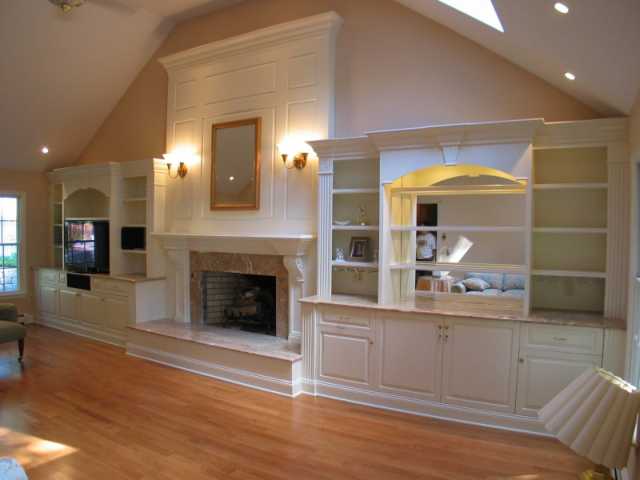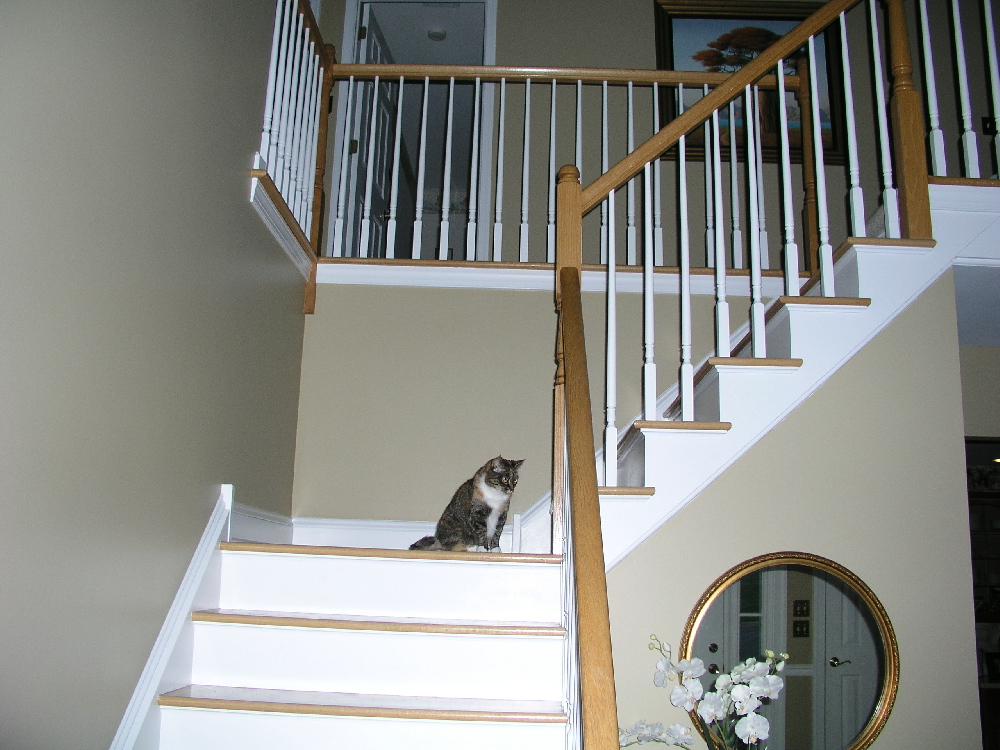Filling Nail Holes in Paint-Grade Work
Pros share a dozen favorite ways to hide the fasteners. June 16, 2005
Question
We are being pulled into paint grade built-in work by some of our existing clients who we have done furniture grade work for. All of this work is done off site, finished off site and then brought to the home for installation. When there is trim involved, there are nail holes to deal with. Since these are already painted (usually white), we are looking for good filling tricks for the nail holes that we can then touch up paint over. In our furniture grade work, we never had to deal with this, since we had a wide variety of fillers and stain we could use.
Forum Repsonses
(Cabinet and Millwork Installation Forum)
I'm pretty sure Minwax makes a finishing putty in white, and a cream... You can use these just like the wood ones, mixing colors if needed.
White wax sticks. Home Depot. Rub in, then buff. Easy, fast and invisible.
If you're willing to touch up the paint, Bondo is a great filler for paint grade. Dries fast, (faster if you make a hot batch), sandable, paintable, etc. Try it.
Have you tried installing this paint grade trim with a 23 ga.gun? A little hot glue on the back and a small pinhole to fill. That's where I'd start.
Not sure I'd trust the 23ga + hot melt for long term holding of crown and heavy trim moldings.
Absolutely not for large mouldings. I was judging by your post that you were trimming built-ins mostly. For any larger mouldings, Bondo is what the pros use.
Generally, that is the job of the painter or finisher. Bondo, wood putty and spackle come to mind for fixing defects.
From the original questioner:
I'm the painter and finisher. These are turnkey installs. I'll have to try some Bondo. The wood putty simply takes too long to dry and shrinks too much.
I use seam fil. White is easy to match and I've had good luck mixing from different tubes to come very close on colors. Cleanup is with lacquer thinner, so be sure it won't cut the finish you are using.
It sounds like the best filler available is Bondo for paint grade jobs. Bondo offers an endless list of different fillers for different types of jobs. Which Bondo product are you using? The "Bondo Ultimate Filler" looks like it would do the job, but I'm not sure which product to use when filling nail holes in wood.
No bondo, no spackle, no linseed oil putty, and seamfil will probably be too hot for surrounding finish. If you get your wax stick warmed up enough, that is the way to go for speed and quality. But, follow that up with a topcoat of the material used to paint the finish coat. If you can find a spray can that matches color and is of same material, you have it made. If not, have finisher use a detail touch-up gun to blend defects. I doubt any wax stick will match the topcoat. Also, any blemish left uncoated will catch dirt and discolor so filled holes will eventually stand out to testify to your workmanship.
While you are chasing down auto-body fillers, consider Evercoat's glaze coat, which has a patented formula to make it stick. It adheres and sands much better than the thicker Bondo... dries in about the same amount of time. Use Bondo for big gaping holes and the glaze for the small stuff. I've only found it at the auto body supply stores. You'll be happy with it. A great product!
The only drawback to the Bondos and other fillers is that they are not white and need to be primed. Bondo usually comes with red catalyst, which takes more priming to cover than the wood.
So anyone out there found a truly white filler? I've heard of a white auto body glaze called Nitro or something like that. It amazes me that none of the paint/finish suppliers have a white wood filler.
Famowood white, for example, is about the color of maple. They should be charged with fraud for calling their product white.
I don't like using waxes or putties or drywall compounds as fillers on cabinets, but I do it because of lack of a truly white filler. Spackle is dead white... but not furniture grade, subject to shrinkage and falling out.
Thought I'd throw my vote in for seam fil. We use CV and seam fil doesn't hurt it. Regular NC lacquer will get eaten up unless you can think of another way to level the seam fil without lacquer thinner. I remember that Form Fill makes a water based filler - that's the way to go for lacquer.
As soon as trim goes up, we slightly overfill with Elmer's wood putty. While we are finishing everything else, mounting hardware, adjusting doors, cleaning up, etc. the putty dries. The very last thing we do is take a damp sponge and rub off excess to level. I find this better than sanding, since it doesn't mar surrounding finish. Then spot touch up with an artist brush with same topcoat and you're done. Perfect match. We also precut and mount all trim possible to unit before finishing in shop, so only crown to ceiling and shoe are nailed on site. If possible, we use biscuits to mount scribes, so there are as few nail holes as possible.
This unit was completely built in shop with all mouldings pre-attached to their corresponding parts and pre-finished. The columns to walls were scribed to fit on site and biscuit on. The only thing face nailed was the shoe. It may seem like it is longer to do it this way, but the time saved on jobsite and the finished look far outweigh doing all the trim work on site. If it were running full to ceiling, we would have mounted frieze beforehand and only cut and fit final crown on site.

Click here to view full size image
I put up all my trim with 23 ga pins and PL premium. Plenty of working time (as opposed to hot glue) and incredibly strong.
We've been using Bondo for years. The Bondo brand stuff you get most everywhere is a really poor product. If you look in the ingredients list, the cheap fillers are polyester and talc. The better products mostly use glass microspheres in place of talc. This is what makes it hard and easy to sand at the same time.
The best source I have found is a chain of auto supply stores called NAPA. I don't know if it's national but it is all over the Northeast. The product is called MicroLight (space age lightweight bodyfiller). It used to have an astronaut on the can. I pay about $12 for a gallon. Creamy and spreads to a feather edge. If you have your heart set on white Bondo, go to your nearest marine store and pick up some Formula 27. The trick is it comes with white catalyst.
I use wax fill sticks. Sometimes I have to melt them together to get the color dead on. Usually that's it, other than a light buffing with a white scotch brite and from time to time I'll aerosol on a clear coat to help match the sheen.
Mohawk makes some nice sets, as does J.E. Moser, and now Fastcap has put out a pretty neat set that is not really sticks but more like big, half cylinder shaped chunks of wax color fill. Real quick to do and not messy. Almost everything I install is pre-finished in some form or another, and I've found this is my preferred method.
We recently did an oak kitchen set, finished with MacLac and whitewash mixed together and we found that an ordinary Crayola crayon (white) was easy to apply, cheap and readily available. It matched way better than any putty. Also a wide range of colors to pick from. Sounds bad, but try it first and see for yourself.
I have used a product called Red Devil One Touch. It is basically a lightweight water based spackle. It dries quickly and can be painted over immediately with water based paint or in two hours with oil based. Very little shrinkage, unless you dilute it. Apply with finger tip or flexible putty knife. If you apply carefully, no sanding is needed. Otherwise, wait 15 minutes and sand with 220 no-load paper and then apply your touchup to seal the surface.
Here in Australia it is quite common to use a trick that, I believe, comes from sign installers. To avoid any fixing holes in stick on components, mouldings, etc., use bits of thin double-sided tape interspaced with small neat blobs of clear silicone. The idea is that the tape will hold the item in position until the silicone goes off and as long as the surfaces are free from any moisture, grease or dust, the adhesion achieved is more than adequate for most situations. An alternative is to replace the silicone with any suitable adhesive.
I use two ways. The first is a white powder floor leveler mix with water. It dries as fast as Bondo and sands much easier. The second for small nail holes is baby powder mixed with the paint to be used and make a paste. Use a small brush and fill the hole. After, lightly wipe your finger across the filled area.
Bondo is for vehicles. I understand that it does work and for patching some drastic holes like passage set holes drilled wrong or something. If you are resorting to Bondo, you might as well use 20, 45, or 90 minute Durabond or a setting type joint compound. Much easier to tool and water based - just don't wash up in the customers sink.
I can't believe no one mentioned the product Rock Hard, perfect for paint grade nail holes, doesn't shrink, sets fast and is made for professional woodworkers like us. I apply it like color putty, leaving a bit more in the hole than needed and in a few minutes I go back with a damp rag or sponge and carefully wipe until the hole is filled properly. Another product that works well when used correctly and is pure white is Tub and Tile caulk. Again, leave it set for a while, then wipe with a damp cloth. Sometimes a second application is needed to compensate for shrinkage in larger nail holes.
The comments below were added after this Forum discussion was archived as a Knowledge Base article (add your comment).Comment from contributor I:
I use Durham's rock hard putty, however it is a chamois color and has a slightly fibrous texture. Recently, I used a mixture of plaster of Paris and gum arabic and water to fill pottery cracks and it is white as can be, dries hard, easy to sand, not fibrous and stays white. Just something you can try. You have to mix it up. You can also use epoxy putty to fill holes and it comes in several colors, kind of expensive but dries rock hard, smooth and doesn't shrink.

